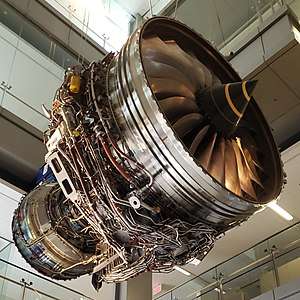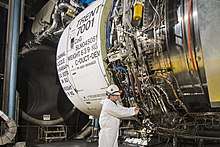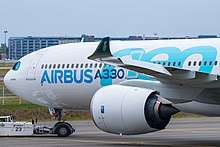Rolls-Royce Trent 7000
The Rolls-Royce Trent 7000 is a high-bypass turbofan engine produced by Rolls-Royce, an iteration of the Trent family powering exclusively the Airbus A330neo. Announced on 14 July 2014, it first ran on 27 November 2015. It made its first flight on 19 October 2017 aboard on the A330neo. It received its EASA type certification on 20 July 2018 as a Trent 1000 variant. It was first delivered on 26 November, and was cleared for ETOPS 330 by 20 December. Compared to the A330's Trent 700, the 68,000–72,000 lbf (300–320 kN) engine doubles the bypass ratio to 10:1 and halves emitted noise. Pressure ratio is increased to 50:1, and it has a 112 in (280 cm) fan and a bleed air system. Fuel consumption is improved by 11%.
| Trent 7000 | |
|---|---|
 | |
| The Trent 7000 is a bleed air enabled version of the Trent 1000 (pictured) | |
| Type | Turbofan |
| National origin | United Kingdom |
| Manufacturer | Rolls-Royce Holdings |
| First run | 27 November 2015[1] |
| Major applications | Airbus A330neo |
| Unit cost | US$37.9M (2014 list price)[2] |
| Developed from | Rolls-Royce Trent 1000 |
Development

Announced on 14 July 2014 at the Farnborough Airshow, the Trent 7000 is the exclusive engine for the Airbus A330neo, succeeding the Trent 700 used for the Airbus A330.[3] It first ran on 27 November 2015 on a test bed in Derby.[1] Although the first two test engines will be made in Derby, further test engines and production Trent 7000 will be assembled in the Rolls-Royce Singapore facility.[4]

In 2015 Rolls experienced development problems with the Trent 1000 TEN, and had to involve extra resources to support the on-time March 2017 787-10 maiden flight but it led to delaying the Trent 7000.[5] The first pair of engines were shipped to Airbus in June 2017.[6] It made its first flight on 19 October 2017 aboard its A330neo application, directly after ground testing which included altitude, icing, cross-wind, noise and cyclic testing in USA, and endurance, operability and functional performance testing in UK.[7]
As it is based on the Trent 1000, it could share its durability problems and that could deter buyers, fixes should be available six months after the plane is introduced in summer 2018.[8] Rolls-Royce's CEO Warren East said the 7000 was not affected by the Trent 1000 issues.[9]
It received its EASA type certification on 20 July 2018.[10] It is certified as a Trent 1000 variant.[11] This was delayed from the initially planned first quarter of 2017. At the time, ETOPS testing was halfway through as 3,000 engine cycles are planned, to be completed by early August. The engine should then be stripped and reported by the end of September, for an ETOPS certification in time for the year-end introduction.[12]
By August 2018, quantity production was challenging and in October Rolls-Royce expected 500 large engines deliveries in 2018, down from 550.[13] Rolls confirmed 10 deliveries by the end of October, below the 30 needed for 15 A330neos deliveries by year-end.[14] The A330-900 was initially cleared for 180 min ETOPS with a limitation of 500 engine cycles for the first delivery to TAP Portugal on 26 November. Full ETOPS requires an EASA approval plan with a 3,000 cycles validation test plus three simulated diversions followed by disassembly and examination before the end of December.[15] ETOPS 330 was secured by 20 December.[16]
In 2019, Rolls-Royce delivered 106 Trent 7000s, up from eight in 2018, while it achieved a 99.9% dispatch reliability.[17]
Design
Its architecture comes from the latest version of the Trent 1000, the TEN, using the A330's Trent 700 experience and technology from the Trent XWB. The 68,000–72,000 lbf (300–320 kN) engine doubles the bypass ratio and halves emitted noise compared to the Trent 700.[3] Maximum pressure ratio is increased to 50:1 from 36:1 and it has a bleed air system for environmental control and wing anti-icing.[18]
Compared to the 20-year-older Trent 700 introduced in 1995, the Trent 7000 features a larger fan —112 inches (2.8 m) compared to 97 inches (2.5 m)— associated with a smaller fan hub. This doubles the bypass ratio from 5 to 10.[19] It has the highest bypass ratio of any Trent engine.[20] The fan has 20 blades.[21]
The overall pressure ratio increases thanks to Trent XWB core compressor technology, improving thermal efficiency. This is associated with a 200-Kelvin increase in internal temperatures; Thermally-coated high-pressure turbine blades are used instead of the more expensive ceramic matrix composites, which will be used in 2020 with the next Rolls-Royce engine generation. The larger fan and higher bypass ratio require two more stages in the low-pressure turbine; the engine is heavier.[19] The Trent 7000 weighs 6,445 kg (14,209 lb),[11] while the Trent 700 weighs 6,160 kg (13,580 lb):[22] 285 kg (628 lb) more.
Despite the additional weight and the extra drag resulting from the wider diameter, Rolls-Royce reports fuel consumption will improve by 11%. Since bleed air is used instead of electrical power generation (as in the 787's Trent 1000), the IP accessory drive is less loaded and enables the high-pressure compressor to maintain stability at low power settings, improving low-speed fuel consumption for short-haul operations. The engine features active turbine clearance control providing the optimal level of cooling air for different phases of flight.[19]
At take-off, the fan displaces up to 1.3 t (2,900 lb) of air per second, the jet nozzle velocity is almost 1,000 mph (450 m/s) and each high pressure turbine blade generates around 800 hp (600 kW), rotating at 12,500 rpm with their tips reaching 1,200 mph (540 m/s).[7] Rolls-Royce reports the engine is 10 dB quieter than the Trent 700.[12]
Specifications
Data from EASA[11]
General characteristics
- Type: Three-shaft turbofan
- Length: 4775 mm / 188 in
- Diameter: 2.85 m (112 in) fan (20 swept fan blades[23])
- Dry weight: 6,445 kg (14,209 lb)
Components
- Compressor: axial, 8 stages IP, 6 stages HP
- Combustors: single annular combustor with 18-off fuel spray nozzles
- Turbine: axial, 1 stage HP, 1 stage IP, 6 stages LP
Performance
- Maximum thrust: 324.0 kN / 72,834 lbf (Take-Off) ; 289.2 kN / 65,005 lbf (Continuous)
- Overall pressure ratio: 50:1[23]
- Bypass ratio: 10:1[23]
- Air mass flow: 1.3 t (2,900 lb) per second (take-off).[7]
- Turbine inlet temperature: > 1,835 K (1,562 °C; 2,843 °F) max Turbine Entry Temperature
- Specific fuel consumption: -10% against current today’s Trent 700[23]
- Thrust-to-weight ratio: 5.13
- Rotating speed: (100%) HP 13,391 rpm, IP 8,937 rpm, LP 2,683 rpm
See also
Related development
Comparable engines
Related lists
References
- "Rolls-Royce celebrates first run of Trent 7000 demonstrator engine" (Press release). Rolls-Royce Holdings. 27 November 2015.
- "Rolls-Royce wins Trent 7000 order worth $455M from Hawaiian Airlines" (Press release). Rolls-Royce Holdings. 18 December 2014.
- "Airbus selects Rolls-Royce Trent 7000 as exclusive engine for the A330neo" (Press release). Rolls-Royce Holdings. 14 July 2014.
- "Rolls-Royce Developing New Engines in Singapore". Aviation Week. 16 February 2016.
- Guy Norris (9 June 2017). "Rolls Readies For Dual Debuts At Paris But Misses Out On A330neo Airbus A350-1000 and Boeing 787-10 show debuts boost Rolls, but Airbus A330neo delay highlights strategy risks". Aviation Week & Space Technology.
- Michael Gubisch. "Rolls-Royce sends first Trent 7000 pair to Airbus 16 June 2017". Flightglobal.
- "Rolls-Royce Trent 7000 powers Airbus A330neo first test flight" (Press release). Rolls-Royce. 19 October 2017.
- "Rolls-Royce 787 Engine Snag Extends to Airbus A330". Bloomberg. 23 March 2018.
- Sarah Young (15 June 2018). "Rolls-Royce CEO says Trent XWB, Trent 7000 not affected by Trent 1000 issues". Reuters.
- "Rolls-Royce Trent 7000 gets ticket to fly as first production engines arrive in Toulouse" (Press release). Rolls-Royce. 20 July 2018.
- "Type certificate data sheet E.036" (PDF). EASA. 20 July 2018.
- Guy Norris (15 July 2018). "Rolls-Royce Poised For Trent 7000 Engine Certification". Aviation Week & Space Technology.
- Paul Sandle, Tim Hepher (26 October 2018). "Rolls-Royce hit by delay to engine for new Airbus jet". Reuters.CS1 maint: uses authors parameter (link)
- Cathy Buyck (26 October 2018). "Rolls-Royce's Trent 7000 Deliveries To Fall Short of Target". AIN online.
- David Kaminski-Morrow (27 November 2018). "Trent 7000 delays held up full A330neo ETOPS clearance". Flightglobal.
- David Kaminski-Morrow (20 December 2018). "A330neo engine secures 330min ETOPS clearance". Flightglobal.
- David Kaminski-Morrow (28 February 2020). "Rolls-Royce nears break-even delivery for A350-900 powerplant". Flightglobal.
- Guy Norris (14 July 2014). "Rolls-Royce Details Trent 7000 Plans For A330neo". Aviation Week.
- "The All-New Rolls-Royce Trent 7000". airinsight. 23 July 2014.
- "Trent 7000". Rolls-Royce.
- "Trent 7000 infographic". Rolls-Royce.
- "Type-Certificate Data Sheet RB211 Trent 700 series engines" (PDF). EASA. 18 April 2018.
- "Trent 7000". Rolls-Royce Holdings.